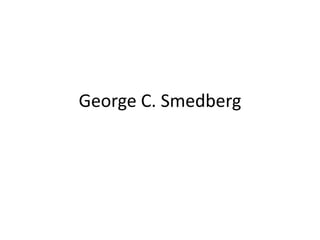Smedberg presentation from work at yale
- 3. Pre 1803- Candles and then floating oil lamps 1803- Lyceum Theatre Debuts Gas Lighting (Float Position, America calls the footlight) 1837- Limelight Introduced (oxy-hydrogen flame, heating piece of lime) 1830ŌĆÖs- ARC lighting introduced (no effective method to maintain/ provide current) 1846- ARC used to simulate sun with color screen and parabolic mirror 1860- Paris, ARC with lens, shutters, spherical mirror and hoods to form first spotlight 1870- Dynamo- first steady electric current production 1879- Edison introduces Bamboo filament Incandescent lamp 1911- Tungsten first able to be drawn into a filament, Nitrogen Gas filled lamp 1920- 98 percent Argon, 2 percent Nitrogen gas introduced
- 4. Publication Date June 12, 1996
- 9. LINNEBACH PROJECTOR-HELPED DEVELOP THE WESTLITE PROJECTOR Custom made projections using paint on acetate sheets of plastic. Soft focus projections only. Large piece of equipment, difficult to hide at times. Fairly dim. Largely replaced by glass gobo technology. Vern Reynolds ŌĆö A Plea for Linnebach Projection 211 George Smedberg, a representative of the Associated Lighting Service of San Francisco, consulted with Delford F. Brummer, technical director of the Stanford University Theatre, to produce this instrument ŌĆö The Westlite Projector. After a series of rigorous tests performed on the stages of Stanford's Memorial Auditorium using the Westlite Projector, I heartily recommend it as a definite step forward in Linnebach design.








